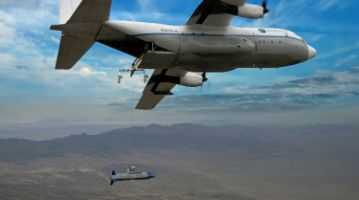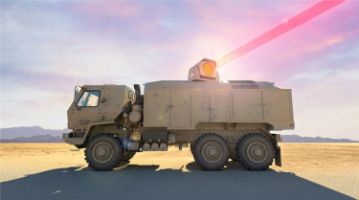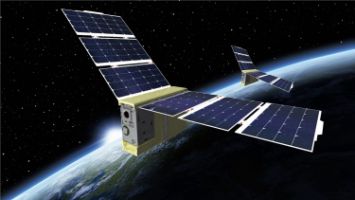Dynetics achieves critical NASA milestone and delivers key data on lunar lander program
HUNTSVILLE, Ala., Jan. 6, 2021 /PRNewswire/ -- Dynetics, a wholly owned subsidiary of Leidos, has submitted its proposal for Option A of the Human Landing System (HLS) for NASA's Artemis Program. The Dynetics team has also completed the HLS Continuation Review, a critical milestone during the 10-month base period, which NASA will use to assess progress on HLS hardware development and program plans.
At the Continuation Review, Dynetics provided details to NASA on its early design efforts, mission plans, and its hardware and software build as well as test activities that demonstrate tangible, robust advancement towards NASA's mission objectives.
Dynetics is currently performing tests of its main engines simultaneously at its propulsion test site and at NASA's Marshall Space Flight Center (MSFC), both in Huntsville, Ala. This collaboration uses Dynetics' and NASA's expertise in oxygen/methane propulsion at their facilities. These tests provide data on the performance and stability of the engines to improve final designs before qualification.
Dynetics has conducted tests of its smaller reaction control system (RCS) engines at its own facilities, gradually progressing through more challenging and flight-like test conditions.
Dynetics continues to utilize a low-fidelity hardware test article and has recently added a low-fidelity software test article (or "simulator"), provided by Draper Laboratory. The new simulator component enables early human-in-the-loop (HITL) testing of the Dynetics HLS guidance, navigation, and control software.
"Our team is making great progress on our system design and analysis, hardware development, and testing. The incredible volume of technical data and outstanding products delivered to date speak to the power of the swift, yet rigorous, engineering approach with which the team has executed," said Kim Doering, vice president of space systems at Dynetics. "We believe this body of work lays a solid foundation for our crew-centric, sustainable solution to become NASA's choice for safe human transportation to and from the lunar surface."
Industry experts provide key design elements
Dynetics leads a global team of industry-recognized experts with human spaceflight and hardware/software experience directly applicable to the HLS. All members have made significant contributions to the team's progress to date.
Sierra Nevada Corporation (SNC) led the completion of a medium-fidelity hardware test article, which is located at NASA's Johnson Space Center (JSC) in Houston, Texas. Like its low-fidelity siblings, this test article will be used by NASA astronauts and operators to improve the Dynetics crew module design. Among many other early demonstrations, SNC has created a virtual reality simulator to evaluate how future crews would view the lunar surface and landing site on approach.
Houston-based Oceaneering has provided design and development of crew system intra-vehicular and extra-vehicular activities (IVA/EVA) and crew training plans. Oceaneering recently supported successful completion of the preliminary design reviews for crew operations and crew systems held in October and December, respectively. The company has also completed dust mitigation technology demonstrations, using its Debris Vacuum Assembly (DeVA) hardware. Additional dust mitigation technology demonstrations are ongoing at NASA's Kennedy Space Center (KSC).
Paragon Space Development Corporation has reached the Environmental Control Life Support System (ECLSS) preliminary design review within seven months of program kickoff. Key ECLSS component tests were conducted at NASA's Glenn Research Center (GRC). The maturity of Paragon's ECLSS technologies will lead to a faster transition from the critical design review and flight hardware delivery.
Maxar Technologies completed preliminary designs for many of the Dynetics Human Landing System's major subsystems, including its power, avionics and communications and active thermal control subsystems. These preliminary designs and plans will be reviewed by the Dynetics and NASA teams during Subsystem Preliminary Design Reviews in early January 2021.
The Dynetics lander team has also performed detailed analyses on a wide range of mission-specific phenomena, such as the interaction of main engine exhaust plumes with the lunar regolith and computational fluid dynamics (CFD), analysis of cabin airflow to improve the design, and placement of the air revitalization system.
The team will continue with the subsystem- and system-level design reviews and critical technology demonstrations as it awaits NASA's Option A selection decision in early 2021.
About Dynetics
Dynetics, a wholly owned subsidiary of Leidos, provides responsive, cost-effective engineering, scientific, IT solutions to the national security, cybersecurity, space, and critical infrastructure sectors. Our portfolio features highly specialized technical services and a range of software and hardware products, including components, subsystems, and complex end-to-end systems. The company of more than 3,000 employees is based in Huntsville, Ala., and has offices throughout the U.S. For more information, visit www.dynetics.com.
About Leidos
Leidos is a Fortune 500® information technology, engineering, and science solutions and services leader working to solve the world's toughest challenges in the defense, intelligence, homeland security, civil, and health markets. The company's 38,000 employees support vital missions for government and commercial customers. Headquartered in Reston, Virginia, Leidos reported annual revenues of approximately $11.09 billion for the fiscal year ended January 3, 2020. For more information, visit www.Leidos.com.
Statements in this announcement, other than historical data and information, constitute forward-looking statements that involve risks and uncertainties. A number of factors could cause our actual results, performance, achievements, or industry results to be very different from the results, performance, or achievements expressed or implied by such forward-looking statements. Some of these factors include, but are not limited to, the risk factors set forth in the company's Annual Report on Form 10-K for the period ended January 3, 2020, and other such filings that Leidos makes with the SEC from time to time. Due to such uncertainties and risks, readers are cautioned not to place undue reliance on such forward-looking statements, which speak only as of the date hereof.
For more information, contact:
Kristina Hendrix, APR
Dynetics, Inc. Communications Director
256-713-5453
kristina.hendrix@dynetics.com
View original content to download multimedia:http://www.prnewswire.com/news-releases/dynetics-achieves-critical-nasa-milestone-and-delivers-key-data-on-lunar-lander-program-301201762.html
SOURCE Dynetics







